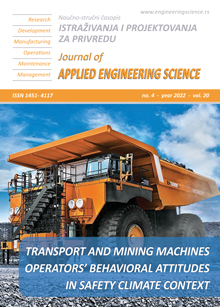BEHAVIOR OF LIGHT-GAUGE STEEL SHORT COLUMNS FILLED WITH NORMAL AND LIGHTWEIGHT AGGREGATE CONCRETE UNDER CONCENTRIC AXIAL LOADING
Abstract
This study aims to investigate experimentally and numerically the behavior of light-gauge steel tubes filled with normal and lightweight concrete under axial loading. A total of thirty-five specimens, including thirty-two composite columns, two bare steel columns, and one normal-weight plain concrete column, were considered. The main variables in the tests were the concrete infill type (normal-weight and lightweight), the column’s length (1, 1.25, 1.5, 1.75-m), the steel tube thickness (2 and 2.4-mm), and the cross-section (100×100 and 150×150-mm). In addition, theoretical capacities were computed according to Eurocode 4, and a finite element analysis was conducted using ABAQUS software. The results showed that the behavior of lightweight filled steel tubes was similar to the normal weight filled tubes during the test; however, their capacities were lower compared to the normal weight filled tubes by a range of (1%-20%). Yet, lightweight filled steel tubes can achieve high axial loads. In addition, the axial capacity of all composite columns decreased with the increase of the column’s height and increased with the increase of both the cross-section and the steel thickness. Current code specifications of EC4 and the numerical results obtained from ABAQUS overestimated the capacities of the composite concrete-filled tubes by 3% and 14%, respectively; however, the EC4 was found to present close estimations to the experimental results.
References
lang=AR-SA style='font-size:11.0pt;mso-ansi-font-size:10.0pt;font-family:"Times New Roman",serif;
mso-ascii-font-family:Arial;mso-hansi-font-family:Arial'>
style='mso-element:field-begin;mso-field-lock:yes'>
lang=EN-US>ADDIN Mendeley Bibliography CSL_BIBLIOGRAPHY
dir=RTL>
0pt;font-family:"Times New Roman",serif;mso-ascii-font-family:Arial;
mso-hansi-font-family:Arial'>
lang=AR-SA dir=RTL style='font-size:11.0pt;mso-ansi-font-size:10.0pt;
font-family:"Times New Roman",serif;mso-ascii-font-family:Arial;mso-hansi-font-family:
Arial'>Patidar, A.K. (2012). Behaviour of Concrete Filled Rectangular Steel Tube Column. IOSR J. Mech. Civ. Eng. 4, 46–52. https://doi.org/10.9790/1684-0424652.>
Soundararajan, A., Shanmugasundaram, K. (2008). Flexural behaviour of concrete-filled steel hollow sections beams. J. Civ. Eng. Manag. 14, 107–114. https://doi.org/10.3846/1392-3730.2008.14.5.>
Han, L.H. (2004). Flexural behaviour of concrete-filled steel tubes, J. Constr. Steel Res. 60, 313–337. https://doi.org/10.1016/j.jcsr.2003.08.009.>
Flor, J.M. Fakury, R.H. Caldas, R.B. Rodrigues, F.C. Araújo, A.H.M. (2017). Experimental study on the flexural behavior of large-scale rectangular concrete-filled steel tubular beams. Rev. IBRACON Estruturas e Mater. 10, 895–905. https://doi.org/10.1590/s1983-41952017000400007.>
El-Nimri, R., Abdel-Jaber, M.S., Hunaiti, Y.M., Abdel-Jaber, M., Behavior of light-gauge steel beams filled with recycled concrete, Mag. Civ. Eng. 101 (2021). https://doi.org/10.34910/MCE.101.2.>
Yang, Y.F. Man, L.H. (2006) Compressive and flexural behaviour of recycled aggregate concrete filled steel tubes (RACFST) under short-term loadings, Steel Compos. Struct. 6, 257–284. https://doi.org/10.1016/j.jlumin.2005.09.005.>
Xie, L. Chen, M. Sun, W. Yuan, F. Huang, H. (2019). Behaviour of concrete-filled steel tubular members under pure bending and acid rain attack: Test simulation, Adv. Struct. Eng. 22, 240–253. https://doi.org/10.1177/1369433218783323.>
Fong, M. Chan, S.T. Chan, S.L. (2011). Capacities of Concrete-filled Steel Beams of Unequal Double Spans by Testing and Code, HKIE Trans. Hong Kong Inst. Eng. 18, 1–5. https://doi.org/10.1080/1023697X.2011.10668217.>
Nakamura, S. ichi. Morishita, H. (2008). Bending strength of concrete-filled narrow-width steel box girder, J. Constr. Steel Res. 64, 128–133. https://doi.org/10.1016/j.jcsr.2007.03.001.>
Jyothi K. N, Valsa Ipe . T, (2015). Performance of Infilled Cold Formed Steel Channel Section Beams, Int. J. Eng. Res. V4 446–451. https://doi.org/10.17577/ijertv4is120523.>
Valsa Ipe, T. Sharada Bai, H. Manjula Vani, K. Iqbal, M.M.Z. (2013). Flexural behavior of cold-formed steel concrete composite beams, Steel Compos. Struct. 14, 105–120. https://doi.org/10.12989/scs.2013.14.2.105.>
Hunaiti, Y.M. (1991). BOND STRENGTH IN BATTENED COMPOSITE COLUMNS, 117, 699–714.
Zhang, S. Guo, L. Ye, Z. Wang, Y. (2005). Behavior of steel tube and confined high strength concrete for concrete-filled RHS tubes, Adv. Struct. Eng. 8, 101–116. https://doi.org/10.1260/1369433054037976.>
L. H. H., T. T. C. H., Load Carrying Capacity of High Strength Cold-Formed Steel Built-Up Box Sections, 1 (2012) 494–499. https://doi.org/10.3850/978-981-08-6218-3_ss-th016.>
De Nardin, S. El Debs, A.L.H.C. (2007). Axial load behaviour of concrete-filled steel tubular columns, Proc. Inst. Civ. Eng. Struct. Build. 160, 13–22. https://doi.org/10.1680/stbu.2007.160.1.13.>
Kuranovas, A. Goode, D. Kvedaras, A.K Zhong, S. (2009). Load-bearing capacity of concrete-filled steel columns, J. Civ. Eng. Manag. 15, 21–33. https://doi.org/10.3846/1392-3730.2009.15.21-33.>
Sakino, K. Nakahara, H. Morino, S. Nishiyama, I. (2004). Behavior of Centrally Loaded Concrete-Filled Steel-Tube Short Columns, J. Struct. Eng. 130, 180–188. https://doi.org/10.1061/(asce)0733-9445(2004)130:2(180).>
Hunaiti, Y.M. (1996). COMPOSITE ACTION OF FOAMED AND LIGHTWEIGHT AGGREGATE CONCRETE, 8, 111–113.
Eltaly, B. Bembawy, A. Meleka, N. Kandil, K. (2017). Structural behavior of recycled aggregates concrete filled steel tubular columns, Chall. J. Concr. Res. Lett. 8, 17. https://doi.org/10.20528/cjcrl.2017.01.003.>
Yang, Y.F. Ma, G.L. (2013). Experimental behaviour of recycled aggregate concrete filled stainless steel tube stub columns and beams, Thin-Walled Struct. 66, 62–75. https://doi.org/10.1016/j.tws.2013.01.017.>
Cortés-Puentes, W.L. Palermo, D. Abdulridha, A. Majeed, M. (2016). Compressive strength capacity of light gauge steel composite columns, Case Stud. Constr. Mater. 5, 64–78. https://doi.org/10.1016/j.cscm.2016.08.001.>
Azad, M.A.K. (2017). Experimental Study on the Strength and Behaviour of Concrete Infilled Light Gauge Steel Square Columns.
Petrus, C. Abdul Hamid, H. Ibrahim, A. Parke, G. (2010). Experimental behaviour of concrete filled thin walled steel tubes with tab stiffeners, J. Constr. Steel Res. 66, 915–922. https://doi.org/10.1016/j.jcsr.2010.02.006.>
Hunaiti, Y.M. (1997). STRENGTH OF COMPOSITE SECTIONS WITH FOAMED AND LIGHTWEIGHT AGGREGATE CONCRETE, ]Ournal Mater. Civ. Eng. 58–61.
Ghannam, S. Al-Ani, H.R. Al-Rawi, O. (2010). Comparative study of load carrying capacity of steel tube columns filled with lightweight concrete and normal concrete, Jordan J. Civ. Eng. 4, 164–169.
Salgar, P.B. Patil, P.S. (2019). Experimental Investigation on Behavior of High-Strength Light weight Concrete-Filled Steel Tube Strut Under Axial Compression, Ina. Lett. 4, 207–214. https://doi.org/10.1007/s41403-019-00077-7.>
Eurocode 4: Design of composite steel and concrete structures-Part 1-1: General rules and rules for buildings. 2004.
A.C.I.E. Bulletin, Aggregates for Concrete ACI Education Bulletin E1-07, Concr. Constr. (2007) 29.
ASTM, ASTM C 127-08: Standard Test Method for Density, Relative Density (Specific Gravity), and Absorption of Fine Aggregate, (2008) 1–7.
American Society for Testing and Materials, 176504562-ASTM-A370.pdf, (1992).
ACI 318. ‘318M–19: Building Code Requirements for Reinforced Concrete and Commentary’; ACI Committee: SanBernardino, CA, USA, 2019; p. 261.
D.S. Simulia, Abaqus 6.14 / Analysis User’s Guide, ABAQUS 6.14 Anal. User’s Guid. I (2014) 862.
"Times New Roman",serif;mso-ascii-font-family:Arial;mso-fareast-font-family:
"Times New Roman";mso-hansi-font-family:Arial;mso-ansi-language:EN-US;
mso-fareast-language:EN-US;mso-bidi-language:AR-SA'>
field-end'>
Allouzi, R. Alkloub, A. Naghawi, H. Al-Ajarmeh, R. (2019). Fracture Modeling of Concrete in Plain and Reinforced Concrete Members, Int. J. Civ. Eng. 17, 1029–1042. https://doi.org/10.1007/s40999-018-0353-5.>

